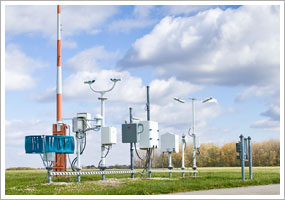ASOS AND AWOS
 Technology has brought an enormous increase in the amount of information—especially weather information—at a pilot's fingertips. During the preflight briefing, you can study conditions at multiple reporting points, thanks to automated surface observation systems (ASOSs) and automated weather observation systems (AWOSs) at many airports. And those same systems are there to help you plan your arrival at many destinations. Include monitoring the station's report on your list of arrival duties before you contact the tower or request an airport advisory at nontowered airports.
Technology has brought an enormous increase in the amount of information—especially weather information—at a pilot's fingertips. During the preflight briefing, you can study conditions at multiple reporting points, thanks to automated surface observation systems (ASOSs) and automated weather observation systems (AWOSs) at many airports. And those same systems are there to help you plan your arrival at many destinations. Include monitoring the station's report on your list of arrival duties before you contact the tower or request an airport advisory at nontowered airports.
"Each ASOS is equipped to transmit weather via voice or computer through telephone or on VHF radio frequencies," Use the Safety Advisor to learn the different service levels of the various ASOS installations—and consider the circumstances under which the information provided is susceptible to inaccuracy or error. You'll also see an explanation of the differences between ASOS and AWOS installations. ASOS is more sophisticated, uses more computer processing, and has better quality control. Note that if a component of an ASOS's weather reporting capabilities is not operating, a code to that effect will appear in its published METAR. For instance, the code TSNO indicates that thunderstorm information is not available—definitely worth knowing during your preflight briefing.
Want to start watching weather trends at a possible destination, or just curious about what's happening at your home airport? Visit this FAA's ASOS Web page to check conditions.
With ASOS information so easily obtainable in a preflight weather briefing by telephone or computer, and from the air by radio, there's no reason not to acquire the most timely reports, then update as you near your destination [see your VFR aeronautical chart, AOPA's Airport Directory, or the Airport/Facility Directory for the correct frequency].
No comments:
Post a Comment